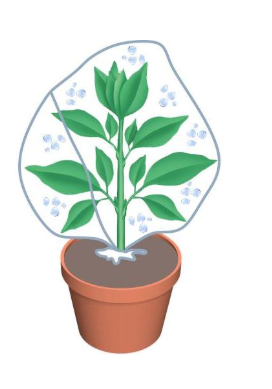Transpiration Class-10 Goyal Brothers Prakashan ICSE Biology Solutions Ch-5. We Provide Solutions of Test yourself , MCQs, Very Short Answer, Short Answer of Exercise-5 Transpiration. All solutions are given as council prescribe guideline for next upcoming exam. Visit official Website CISCE for detail information about ICSE Board Class-10 Biology.
Ch-5 Transpiration Goyal Brothers Prakashan ICSE Class-10 Biology Solutions
| Board | ICSE |
| Publications | Goyal Brothers publications |
| Subject | Biology |
| Class | 10th |
| Writer | Dr. K.K. Aggrawal |
| Chapter-5 | Transpiration |
| Topics | Solutions of MCQ, Very short and Short Answer Questions |
| Edition | for 2022-2023 Academic Session |
Test Yourself-1
Ch-5 Transpiration Goyal Brothers Prakashan ICSE Class-10 Biology Solutions
(Page-66)
Name the following :
1. Two parts of a leaf allowing transpiration ……………….. , …………… .
2. The instrument used to measure transpiration ……………..
3. Time when stomata are open……………
4. The special openings on the older stem for transpiration ……………..
5. A thin layer of wax on the leaf …………………..
Answer :
1. stomata and cuticle
2. potometer
3. day
4. lenticle
5. cuticle
Test Yourself-2
Ch-5 Transpiration Brothers Prakashan ICSE Class-10 Biology Solutions
(Page-67)
A. Write the functional activity against each of the following :
1 Leaf spines and ………..
2 Lenticels and …………….
3. Thick cuticle and …………..
4. Stomata and …………….
Answer :
1. defensive
2. exchange of gasses
3. reduced transpiration
4. transpiration.
B. Fill in the blanks with the appropriate option given below :
1. Transpiration is the …………. (loss/gain) of water from the aerial parts.
2. Major type of transpiration is …………….. (lenticular/stomatal).
3. Transpiration rate is the ……………… (lowest/highest) during summer.
Answer :
1. loss
2. stomatal
3. highest
A. MULTIPLE CHOICE TYPE
Ch-5 Transpiration Brothers Prakashan ICSE Class-10 Biology Solutions
(Page-70)
1. Which of the following is not a function of transpiration?
(a) Cooling of leaves
(b) Uptake of water
(c) Intake of water
(d) Excretion of minerals
Answer : (d) Excretion of minerals
2. Which of the following does not affect the rate of transpiration?
(a) Light
(b) Humidity
(c) Wind
(d) Age of the plant
Answer : (d) Age of the plant
3. Which of the following is an anti-transpirant?
(a) Auxin
(b) Gibberellin
(c) Abscisic acid
(d) Cytokinin
Answer : (c) Abscisic acid
4. The rate of transpiration increases with
(a) increase in humidity of air
(b) increase in wind velocity
(c) reducing light intensity
(d) decrease in wind velocity
Answer : (b) increase in wind velocity
5. Loss of water as droplets from hydathodes is called
(a) Transpiration
(b) Bleeding
(c) Guttation
(d) Evaporation
Answer : (c) Guttation
B. VERY SHORT ANSWER QUESTIONS
Ch-5 Transpiration Brothers Prakashan ICSE Class-10 Biology Solutions
(Page-70)
Question 1. Name the following:
(i) The waxy layer on the epidermis of the leaf meant to reduce transpiration.
(ii) The plant in which stomata are absent.
(iii) A plant with sunken stomata.
(iv) Permanently open structures seen on the bark of an old woody stem.
(v) The loss of water from injured parts of a plant.
(vi) An apparatus that measures the rate of water uptake in a cut shoot due to transpiration.
Answer :
(i) Cuticle
(ii) Submerged aquatic plants
(iii) Nerium’
(iv) Lenticel
(v) bleeding
(vi) potometer
Question 2. Mention if the following statements are true or false. If false, rewrite the sentence by changing only the words printed in bold face
(i) Gaseous exchange occurs in all body cells.
(ii) Transpiration takes place only in aerial parts of the plants.
(ii) Moist cobalt chloride paper turns blue in colour.
(iv) The wall of guard cells towards stomata is thin
(v) Most transpiration occurs during midday.
(vi) Voltmeter is an instrument used to measure the rate of transpiration.
Answer :
(i) False, Gaseous exchange occurs in specific body cells.
(ii) True
(iii) False, Moist cobalt chloride paper turns Pink in colour.
(iv) False, The wall of guard cells towards stomata is thick.
(v) True
(vi) false, Potometer is an instrument used to measure the rate of transpiration.
C. SHORT ANSWER QUESTIONS
Ch-5 Transpiration Brothers Prakashan ICSE Class-10 Biology Solutions
(Page-70)
Question 1. Define the following terms
(i) Transpiration
(ii) Guttation
(iii) Bleeding in plants
(iv) Root pressure
Answer :
(i) The process of giving off vapor containing water and waste products, especially through the stomata on leaves or the pores of the skin
(ii) the exudation of liquid water from the uninjured surface of a plant leaf.
(iii) The exudation of liquid from the cut or injured surface of plants, such as date palm and Palmyra palm is known as bleeding
(iv) root pressure, in plants, force that helps to drive fluids upward into the water-conducting vessels (xylem). It is primarily generated by osmotic pressure in the cells of the roots and can be demonstrated by exudation of fluid when the stem is cut off just aboveground
Question 2. Differentiate between:
(i) Guttation and bleeding in plants.
(ii) Transpiration and evaporation.
(iii) Transpiration and guttation.
(iv) Stomatal transpiration and lenticular transpiration
Answer :
(i)
| Guttation | Bleeding |
| It is the removal of excess water from the plants because of excess water buildup in the plant. | It is the removal of water from the plant because of injury. |
| Water escapes from specialised structures called hydathodes. | Water escapes in the form of sap from the injured part of the plant. |
| It occurs from edges of leaves. | It occurs from cuts found in plants. |
| It happens due to the pressure presents in the xylem. | It happens due to pressure in sieve tubes. |
(ii)
| Evaporation | Transpiration |
| Evaporation is a physical process that can happen from any free surface of water (No living cells needed) | Transpiration is a physiological process which involves loss of water from the plant cells. |
| Evaporation not a controlled process and it stops when the air in the surrounding atmosphere is saturated | Transpiration is a controlled process and is dependent on factors such as osmotic pressure and water potential. |
| Light, pH of the liquid, Carbon dioxide concentration in the atmosphere and hormones do not influence the evaporation process | Transpiration is regulated by factors such as light, Carbon dioxide concentration in the atmosphere, hormones and pH. |
| Evaporation is a relatively fast process | Transpiration is a relatively slow process and occurs through special pores called stomata present in the living cells of the plant. |
| Evaporation continues as long as there is water on the surface | Transpiration process is controlled and depends on the of the availability of water for absorption by the plants. |
(iii)
| Transpiration | Guttation |
| Transpiration occurs through the stomata and lenticels. | Guttation takes place through hydathodes. |
| Loss of Water as water vapour. | Loss of water as liquid water. |
| It occurs during the day. | It occurs during early morning or at night. |
| Takes place at high temperature | Takes place at low temperatures. |
| Dry conditions favor it | Resisted by dry conditions. |
| Excessive transpiration results in wilting. | Guttation never results in wilting. |
(iv)
| Sr. No. | Stomatal Transpiration | Lenticular Transpiration |
| 1. | Loss of water in the form of water vapour through minute pore called stomata. | Loss of water in the form of water vapour through lenticels. |
| 2. | Stomata are confined to epidermis of green shoot and leaves. | Lenticels are confined in woody stem and fruits. |
| 3. | It amounts for 90% to 95% of the water transpired from leaves. | It amounts for 1% to 5% of the total water loss by the plants. |
Question 3. Write one main function of the following :
(i) Stomata
(ii) Hydathodes
(iii) Sunken stomata
(iv) Leaf spines
(v) Lenticels
Answer :
(i) They allow the exchange of gases (CO2 and O2) with the atmosphere
(ii) Hydathode is a plant organ responsible for guttation in vascular plants, i.e. the release of droplets at leaf margin or surface. Because this organ connects the plant vasculature to the external environment, it is also a known entry site for several vascular pathogens
(iii) Sunken means hidden stomata or stomata those which are not directly exposed to surface. It is in a small pit, which protects the escaping water vapour from air currents, decreasing water loss from the leaf.
(iv) Spines: leaves or part of leaves get modified into pointed structures called spines. Spines help to reduce the loss of water by transpiration.
(v) It functions as a pore, providing a pathway for the direct exchange of gases between the internal tissues and atmosphere through the bark, which is otherwise impermeable to gases. The name lenticel, pronounced with an [s], derives from its lenticular (lens-like) shape
Question 4. Give reasons for the following:
(i) The rate of transpiration increases in hot and dry weather.
(ii) Water transpired is water absorbed.
(iii) In some xerophytes leaves are modified into spines.
(iv) Anti-transpirants can be used to keep cut flowers fresh for a long time.
(v) Balsam plants wilt during midday even if the soil is well watered.
(vi) The leaves of certain plants roll up on a bright sunny day.
Answer :
(i) The rate of transpiration increases during hot and dry season because the evaporation is more at the tip of the plant and plant looses more water
(ii) Only a small quantity of this water (about 2%) is used by the plant in photosynthesis and other activities. The rest of it is almost lost to the atmosphere as water vapour as a result of transpiration. Therefore, water transpired is water absorbed.
(iii) In some xerophytes leaves are modified spines to reduce transpiration process as xerophytes are mainly found in in deserts where there is water scarcity. As leaves are modified into spines their surface area is reduced hence transpiration will be less
(iv) Antitranspirants are used to reduce the process of transpiration. These are generally applied to cut flowers and transplanted shrubs etc thus preventing them from early drying out by bloacking the hydrogen ion transport from the stomatal cells
(v) The transpiration rate in such plants is very high during mid-day and exceeds the water absorption rate of the roots. So more water is lost than absorbed. This water deficiency in cells causes them to lose turgidity and the plants wilt.
(vi) The leaves of certain plants roll up on a bright sunny day to reduce the exposed surface and thus reduce the rate of transpiration.
— : End of Transpiration Class-10 Goyal Brothers Prakashan ICSE Biology Ch-5 :–
Return to :- ICSE Biology for Class 10 Goyal Brothers Prakashan solutions
Thanks




